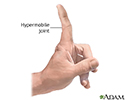Hypermobile joints
Joint hypermobility; Loose joints; Hypermobility syndrome
Hypermobile joints are joints that move beyond the normal range with little effort. Joints most commonly affected are the elbows, wrists, fingers, and knees.
Considerations
Children's joints are often more flexible than adults' joints. But children with hypermobile joints can flex and extend their joints beyond what is considered normal. The movement is done without too much force and without discomfort.
Thick bands of tissue called ligaments help hold joints together and keep them from moving too much or too far. In children with hypermobility syndrome, those ligaments are loose or weak. This may lead to:
- Arthritis, which may develop over time
- Dislocated joints, which is a separation of two bones where they meet at a joint
- Sprains and strains
Children with hypermobile joints also often have flat feet.
Causes
Hypermobile joints often occur in otherwise healthy and normal children. This is called benign hypermobility syndrome.
Rare medical conditions associated with hypermobile joints include:
-
Cleidocranial dysostosis
Cleidocranial dysostosis
Cleidocranial dysostosis is a disorder involving the abnormal development of bones in the skull and collar (clavicle) area. The condition is passed ...
Read Article Now Book Mark Article - Down syndrome
-
Ehlers-Danlos syndrome
Ehlers-Danlos syndrome
Ehlers-Danlos syndrome (EDS) is a group of inherited disorders marked by extremely loose joints, very stretchy (hyperelastic) skin that bruises easil...
Read Article Now Book Mark Article -
Marfan syndrome
Marfan syndrome
Marfan syndrome is a disorder of connective tissue. This is the tissue that strengthens the body's structures. Disorders of connective tissue affect...
 ImageRead Article Now Book Mark Article
ImageRead Article Now Book Mark Article -
Morquio syndrome
Morquio syndrome
Morquio syndrome is a disease of metabolism in which the body is missing or does not have enough of a substance needed to break down long chains of s...
Read Article Now Book Mark Article
Home Care
There is no specific care for this condition. People with hypermobile joints have an increased risk for joint dislocation and other problems.
Joint dislocation
A dislocation is a separation of 2 bones where they meet at a joint. Joints are areas where 2 bones come together. A dislocated joint is a joint whe...

Extra care may be needed to protect the joints. Ask your health care provider for recommendations.
When to Contact a Medical Professional
Call your provider if:
- A joint suddenly appears misshapen
- An arm or leg suddenly does not move properly
- Pain occurs when moving a joint
- The ability to move a joint suddenly changes or decreases
What to Expect at Your Office Visit
Hypermobile joints often occur with other symptoms that, taken together, define a specific syndrome or condition. A diagnosis is based on a family history, medical history, and a complete physical exam. The exam includes a close look at your muscles and bones.
The provider will ask about the symptoms, including:
- When did you first notice the problem?
- Is it getting worse or more noticeable?
- Are there other symptoms, such as swelling or redness around the joint?
- Is there any history of joint dislocation, difficulty walking, or difficulty using the arms?
Further tests may be done.
References
Deeney VF, Arnold J, Moreland MS, Ward WT, Davix HW. Orthopedics. In: Zitelli BJ, McIntire SC, Nowalk AJ, eds. Atlas of Pediatric Physical Diagnosis. 6th ed. Philadelphia, PA: Elsevier Saunders; 2012:chap 21.
Krakow D. Heritable diseases of connective tissue. In: Firestein GS, Budd RC, Harris ED Jr., Gabriel SE, MacInnes IB, eds. Kelley's Textbook of Rheumatology . 9th ed. Philadelphia, PA: Elsevier Saunders; 2012:chap 105.
-
Hypermobile joints - illustration
Hypermobile joints are joints that move beyond their normal range of motion with little effort from the individual.
Hypermobile joints
illustration
Review Date: 11/20/2014
Reviewed By: Neil K. Kaneshiro, MD, MHA, Clinical Assistant Professor of Pediatrics, University of Washington School of Medicine, Seattle, WA. Also reviewed by David Zieve, MD, MHA, Isla Ogilvie, PhD, and the A.D.A.M. Editorial team.

